To begin at the beginning.
Beginish.
A low grassy island forefront to The Great Blasket. One of its piles of rock was discernable as the shell of a cottage. In two accounts, visiting Englishmen spent summers there, fishing for lobsters.
It still feels like the likely refuge for a solitary, but had probably supported a few families on its scrap of land in the days when Blasket had over two hundred souls living onshore..
The Great Blasket.
A name that catches the island's simple grandeur. A statement of defiance. A three mile long spine of grass and heather, dropping away in sheer cliffs to a deep blue sea. On the landward, eastern end, the slope shapes to an open and generous saucer of cultivable land. Below that a fine beach, the White Strand.. Between was where the village stood, now mostly in ruin. Instead of potatoes there is now pasture.
We walked there, courted by three hares, and distracted by sweet field mushrooms. On the strand below a litter of rocks disintegrated as we approached into an encampment of seals.
The inflatable that had brought us in was now tied back onto the Blasket Princess and headed back to Dunquin across a splashy sea.
We had a day on the Blasket.
I had been reluctant to go.
As you get older, you treat dreams gently in case they shatter. The Blasket has harboured key dreams of mine ever since I had read Maurice O'Sullivan's "Twenty Years A'Growing " ever so long ago.
From Eigg and Mull to The Great Blasket, this year has been a lesson in Islandhood for me.
I am not alone in caching my dreams there.
Just as America was a Land of Hopes and Dreams to an exhausted and hungry Dingleman, so the Emerald Isles lure many an American as their cultural inheritance. "Next Parish America" is another name for the Blaskets.
Islands are a metaphor for us all. An abandoned island holds an even stronger potency.
On The Isle of Harris, there seemed to be an overbearing fascination with St Kilda. An islander's island.
As if the reality of modern island life, with its mixed feelings of denial and old closeness is fed by reference to simpler times.
The last of a diminishing population left St Kilda in 1930.
Their morale was gone. They became an oddity to be visited by rich schooners, and felt increasingly isolated.
Just before they left the Blasket for good, the people there had appealed for help from the Irish government after a long spell of bad weather. They were testing the tribal ties of a new Ireland. Support didn't come.
The St Kildans' sent out their first 'mailboat' appeal for help in 1873. A home-madetoy wooden boat enclosed the message.
Both Peoples' had been depleted by emigration and were increasingly dependent on outside resources. Tobacco had long linked Blasket to the mainland economy, but then tea and sugar and countless other comforts that creep in make that connection feel vital.
That stuff of Civilization.
If only they could have hung on another fifty years. That dress rehearsal for Armageddon, the 60's would have fed them a few wild souls. Green tourism would have treated their lifestyle and produce with respectful fascination. The EU would have showered both islands with grant aid.
Perhaps we are better off with an empty canvas of fields and ruins to project our own versions of past and future onto.
things that come to mind about healing the earth, and us on it. some are unfinished bits of writing, with enough sense, I think, in them to make them worth reading. recent ones are about finding a place on the land, and as one of its people.
Wednesday, 9 July 2008
Friday, 22 February 2008
5>Spain. Ramblings of a Born-Again Hippie.
I wrote this as a notebook about 2000 on the nearest thing I've ever done to a pilgrimage, though I didn't know that at the time.
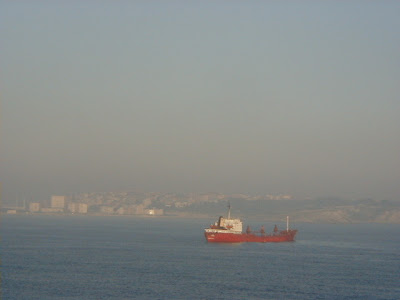
Plymouth is drizzling with a fine summer sweat of anticipation that makes the ferry decks squeak with trainers. We perch like pigeons gazing south. Family man and family woman and their wriggling cherubs.
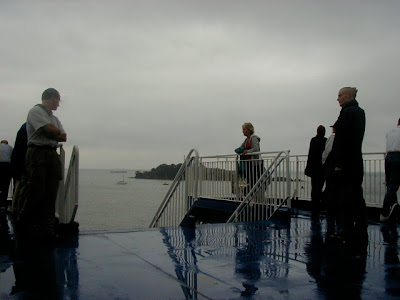
The deck starts to vibrate with volcanic engines and the ship vents a siren blast. Plymouth starts to shift askew.
We wander from deck to deck. Marauding rats. The instincts of familihood have mutated; gone rampant as a flag under which the worst of our selfishness can be expressed. I sit down opposite an old Indian lady in a white embroidered dress. She has bottled water and her shoes on the carpet by her feet. The marauding families scurry by.
The wake of this ferry is enormous, frothing the sea into a peppermint sorbet.
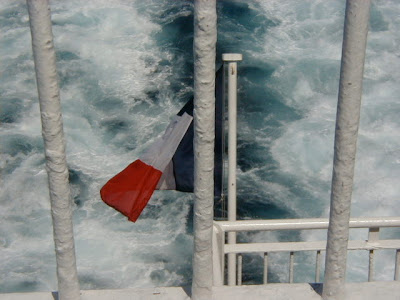
Kids fiddle hoping, with mobile-phones like a fading hot-line to god.
There is a classic female form that is pear-shaped. It is best not served with a custard of bad posture and diet. It certainly doesn’t suit men.
I would like to think that I am going home. I am fed up with this fat cuckoo culture. It is a neurotic mess.
They regard the absence of other ships to look at and a lumpy sea as some failure in the entertainment system. It must have been strange 200years ago when a sail on the horizon could be friend or foe. Aggressor or victim. Now we slap happy over the world’s sea in disregard.
There’s something to be said for smokers. Tobacco smoke was a wonderful incense. The underlying scent of humanity en-masse is slightly rotten. The overlay of perfumes and discinfectants that we use to disguise the smell of our excretions is nauseating.
Bring back the nosegay! Our own stink is acceptable. My emergency nosegay is to pull my teeshirt up over my face, should I be suddenly assailed by a turmoiling toilet or assault by drains.
It was a politeness to light up a cigarette in public if you farted.
An aromatic wristband, with a personally reassuring smell would be just as appropriate to a world of supposedly clean humanbeings as it was in times of more obvious nasal outrage.
19knots feels like riding a snail’s back across Planet Sea. Our wake curdles to the horizon. Around us the occasional white-horse crests in appreciation as this gargantuan sea-dod slithers past.
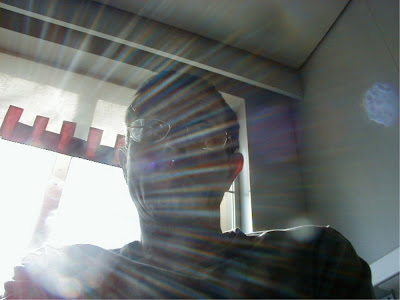
What is this boredom-thing? >the sullen un-engaged attention of the embroid blast&blather humanbeing.
Strange countryside. From the train. Instead of buddleia, festoons of pampasgrass, the ubiquitious bramble & bryony, some marestails.
Spanish are Stylish. They have a proud swing to their walk that is gracious or cruel. The English slab around like rubber ducks, even without their enormous backpacks & bedrolls.
The noses! Did those noble beaks come before, or because of their Pride?
It’s Too Hot. A lot of midday work seems to involve standing in the appropriate garb waiting for it to cool down.
Same industrial sprawl as UK. Pine & some eucalyptus plantations. The houses have pantiles and low-pitch (30degrees) but big overhang. Recognise elder, but not a multi-leaf sorbus tree. It’s hard to tell the colour of distant hillside forests through smoked glass of the train.
TORES PAPEL.> big beat-up green railtrucks with eucalyptus logs sticking out of them. – Pulp?
The pine forests look as single-age/clearfell as ours. A lof of new plantations are Uke. An ash! God-bless fraxinousE. Bracken,fennel,yarrow. A lot of this is railside which has its own discipline. More and more like Wales though.
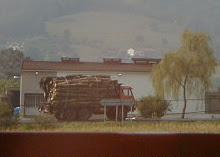
It’s mad. Everyone smokes but the train is non-fumar. They get up individually to stand furtively by the door. One got words from the inspector just now. He nubbed it out and went sheepishly back to his seat.
Above that we climb. The Spanish mid-west. Grain and sunflowers. Mexico. The towns are a spaghetti-western film-set on Salisbury Plain. Clustered around Mother-ship churches. Miles of it.
One small step for a Spaniard. One giant leap for john spikes. The only interesting plants are railside thistles.
LEON.
They like life. They have no hunger to help the ignorant foreigner share their pleasures. The things they enjoy are sensual, so the young are not disadvantaged, as happens in N.Europe. the young inherit the culture readily. They smoke too many cigarettes though.
I reach starvation point before I ventured to order from a menu. The result promises to be a meal richer than my hunger, going by the starter.
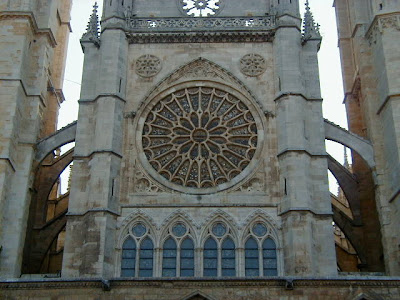
They revere Babies and Dogs. Not plain old mongrels, but pedigree. Not your basic baby, but a little lord, lauded in splendid procession in his super-buggy.
The Old are still in some good-time domain. Shaded benches on plazas allow them to watch the world and play gallant. When they share a table with the young, they still steal the show. Here, there wasn’t the bullying beast of the anglo-saxon Nuclear Family. Couples were a dynamic tryst.
For good or bad.
The cathedral early. A guy was playing single sustained ascending notes on the organ on command from the tuner.
The glass was fantastic. The grotto icons lavish and absurd. God’s house needs a change of furniture.
The pilgrims were there, marked for the main by their canes. Café solo and fresh orange juice.
Leonists are proud to cruel. Cool to rude. A chip on the collective shoulder. The men are the worst. Disthroned Royalty.
WEST TO SANTIAGO.
Spain has a lot of industrial wasteland. Cement-works, quarrying, coal-waste, slate-waste.
Land squandered.
Pines galore in Galicia. A broader needle one to the west. Poplars in the bottomlands. Some Ukes like in the North. Firebreaks cut up to the summits like zips. A lot of local fire-damage.
SANTIAGO
The tortoise-race of backpackers to get to their guidebook hostels. Back in the international circuit of tourism. It helps at feeding time. A menu in English and a waiter who speaks 4 languages.
Shamed by a GrouchoMarx Ingles at near table, who sported a boater, and thought that the key to ethnicity was to eat finger-licking horrible and to be rude to the waiter. A performance clinched with a fat cigar. I avoid words. I have apologised to the waiter. My reward is a very good wine.
Was then invited to join a hen-party on another table. No-one spoke any Ingles. 2 were from the South and had done the 9 day pilgrimage, the other 3 were local friends. The waiter translated.
I thought my bill was hefty. I had paid for their food as well! Ignorant gallantry.
The market is on. Piled with the strangest fruit. A peasant economy overlooked by policia and tourists.
The bus station. Our bus is late, and what was a style-show of competing coach liveries is an almost empty bunker.
Santiago was Bones-R-Us. 1000year old Disney. Get a Stick & Walk the Trail and get a Shell-sticker. Phoney-as-hell. A Catholic theme-park. I fear for the young French girls who sang in sandals, the group of mountainbike pilgrims bunching for a photo in the square.
I head for the coast.
CAMARINAS
This is where I came in.
Monk’s Cave was where I first sat and waited for the world to happen. 30years on and still waiting.
These rocks are a grizzled red, painted by gulls and samphire in the fissures. I have a camera and a radio and carton of wine. Monk’s Cave was more Spartan.
Sitting on rocks with an incoming sea and a dying day. The shore for sure. Wrack to pick. Tides and Storms to talk. Loneliness to share.
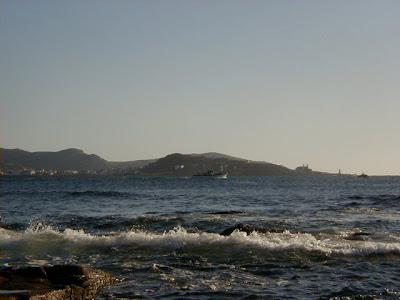
Two ice-white fishing-boats come into view, streaming gulls like a bridal train. The one with most aerial bridesmaids steams ahead, while the other lingers at the mouth of the bay.
At night the lights and movements of large and little boats as they fish.
All that wood.
They don’t use it in their buildings. In the main part these are concrete-frame with hollow block infill. This means you often see a houseframe plus roof (concrete to be dressed with pantiles) left for ages before the next stage. The main wood-use seems to be for shuttering all that concrete, and eventually in details like turned balustrades etc. they have got plastic-window fever. It is even used for their large overhanging bay-windows.
Buses. The Spanish are just as confused, but to cool to show it, and too relieved when they board an appropriate bus to vent their trauma or moan that it is late.
Travel Early. A lot of bus&train activity is before 9am and if you miss that one isn’t until 3or4, so you end up at your destination hot and tired and all the pensions are complet.
There is a peasant farm&forest&fishing holding on the west coast that gets 5stars for bio-diversity, sustainability, all the eco-jargon you can blather.
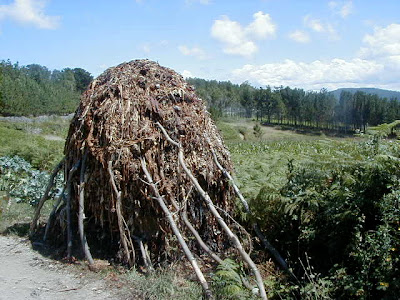
>maize and pine and weird flat-topped brassicas and uke and crustacea and potatoes and fodder; though no evident animal enclosures.
I must find out the cash pyramid of the timber economy here. Big uke goes for pulp. UK timber has an industrial mean of 8foot, both for pulp and construction. Spanish mean looks shorter. Not short enough to manhandle, but too short to allow vertical headroom in structure. There are a lot of small timber mills who stack short sawn baulks out to dry and season.. there is a definite difference of landscape between what looks like the equivalent of the UK Forestry Commission land and peasant land. COTO PRIVADO DE CAZA.
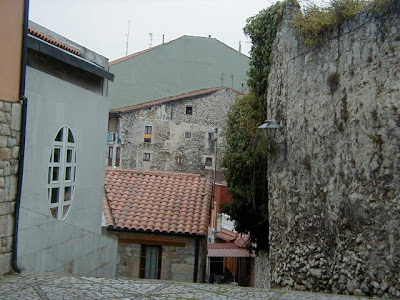
What a day. Trying to get into a bit of someones’ backyard, which is a wild place to you, has similarities to a pilgrimage.
The best eco-systems are still in the hands of, or co-existent with peasants. Walking past them working they looked at me with incomprehension at best, at worst as a threat.
Spanish dogs bark as loud as ours.
You can’t just wander off the road into some unknown.
They live there. They are working the earth. In little parcels. Someone has sneaked a line of pumpkins onto the road-verge behind a fine wall of maize.
They know you are there. And can’t understand why.
CEDEIRA. The north coast.
My spirit sank as the bus got into Cedeira. It’s a squeaky clean resort in a cultivated valley. The slopes are plantation forests.
I trekked out. Again a test for the pilgrim. A pedestrian walking out of camp. I walk. I got looked at. I was hot and tired and uncertain where wilderness was. The houses were proud.. the wayside was full of old friends – wild carrot, marjoram, mint. Then there were the uke forests; well-worked but oppressive. A long valley. My map was inadequate. I turned up in weariness through some new pine plantations to find my destination.
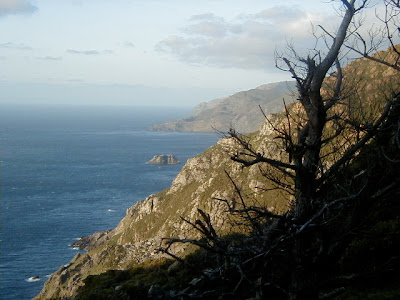
A howling south-east wind. A hollow on the edge of a tumbling cliff-face, under some stunted pines .A savage shore.
Slept. Walked on to San Andreas, a strange peasant church, where the villagers were setting up gimcrack stalls against the wind.
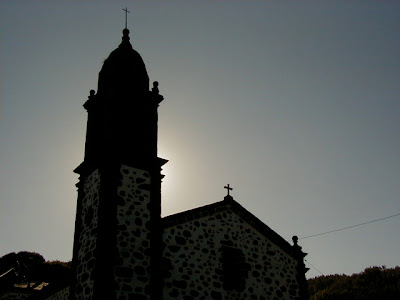
Civilization starts to pile down the road in coach-loads. A lift to Camarinos and a midday beer. Away from that awful wind.
Hitchhiking must have no Spanish word. Their pride and scorn have a field-day in refusing to stop to give a lift. Endless swathes of Uke dress every hillside, with a line of windmills along the summit. No wilderness apparent here.
So I’ve relented, got a bus to a fishing village, O Banquiero and booked a cell in a Pension for 2nights. God-knows what I will do all day. Look at the harbour.
We have ceased to recognise Space as a sacred Part of the Earth. Places emanate Space
which has a flavour and viscosity that is particular. A local air.
The remnant of this knowledge is seen in that old currency of shrines, places of power, extremities. These were only approached appropriately by walking through true space to them, through the ordeal of walking through earth-space.
We have cut this Space and our sense of it to ribbons with our effortless transports; so we never arrive. We take images of our non-arrival away, as totems. As if the currency of collected totems and the splendour of our transports recompense for the fact that we never arrived.
Urban structures and human spaces and our dependence upon them is a poor alternative home for the human spirit. The energy we plunder to construct these ant-heaps is an hysterical attempt to forget what we have lost. Our urban shrines are designed to cater for a large throughput of lost beings, not-arriving (shopping malls, stadiums, city centres). These new shrines generate wealth that encourages the building of bigger ant-heaps. Our splendid transports generate income that encourage cutting more space to ribbons. The materials we use to construct our alternative to space is cropped and quarried from the remnants of real space.
The essence of our civilization is a strategy of savage denial of our loss.
We mock the few humanbeings left living in true space by mimicking aspects of their identity. Systems of conservation, organic foods etc.
I cannot see how we can reverse this ant-hill process. It would be foolish Pol-Pottery to imagine dragging our horde back into what is left of our original space. We are too committed to the pleasures of non-arrival. (lets go, lets go) . Real Space feels glutinous and oppressive to a race heady on the clear clean air of nowhere. Freedom is Movement. A peasant bent over a hoe is not what we really want to be again.
But let the air out of our tyres and the nature of space would change instantaneously. The alternative is to run around like bitten fleas until we exhaust our Host.
A small beach of silver sand, with a quarter of a mile of dune etc. I saw one token clump of sea-holly, but loads more beside. A small light violet flower, marjoram, a dwarf tufted grass etc.
There was a fine litter of broken shells and debris to pick over. The beach is a publically acceptable place of wildness to linger on. It’s good to stop. To kick white sprays of sand. To write with shells and whittle at a piece of driftwood.
The beach is space without the heady oppression of eden. Perfect for non-arrivers.
At least uke drop a leaf-litter. You can say that for them. But in all else, they are like moulting sticks dressed up in widow’s weeds. Enough is enough.
The Spaniards are expert trainers. They master their dogs and horses and children. Their mark is made. There are signs of the pudding-male here too. Men are losing it. The Spanish men don’t feel dressed without a shirt on. Undress on the street is not even considered. Even their teeshirts usually have a collar.
My father was a mechanical engineer. Big brother is an organic chemist. My son will be a microbiologist. I perch precariously on an obscure ledge on the cliff-face of knowledge.
OVIEDO. Is where I am spending money. I bought a pipe, at last, and a good teeshirt.
The Asturians have style. Their graphic sense is superb. There are chic shops with good things from allover. I want to know more about their ceramics- as this is the perfect plastic art for combining graphic and form.
I like this place.
The forests and valleys were not all uke.ok, or el paradiso like in northern Galicia. There was chestnut and hazel and pines and willow. I could live here, with Oviedo as my local city.
I go out to eat and drink. We are in an enclosed square under square white umbrellas, on wooden chairs for once. The flamboyant pouring of sideria from a great height wets the square. I avoid that palaver by ordering red wine, TIERRA ASTUR. Good stuff.
I have left a trail of belongings across Spain. Firstly a phrase-book and a floppy hat that I wouldn’t have worn anyway as it would have been the final flag of a grunge Englishman. Then a pair of half-dry socks & a teeshirt, that I had naively draped across my pack. Left in the streets of Leon. Then there was a day of disaster. I left the rocks of Camarinas early, to catch the bus north, then ran back for my wash-bag. I couldn’t find it. In the square I got hassled by the town-drunk for tobacco. I must have dropped my pipe in the road as I boarded the bus.
“I left my pipe in Camarinas”. I then found that one of my two pairs of trousers was so glued with oil from the beach that they were finished. The final loss was my sunglasses, left as I had perched to drink from a spout on the trek out of Cedeira.
A week of that kind of loss, and I would have disappeared.
I broke the Oviedo pipe by sitting on it halfanhour before the train left. Miraculous quest for supaglue.
OVIEDO. It’s not just the streets are clean.(they seem to spend most of the early hours power-cleaning them) They are expert at attractive and comfortable paving; puckered marble, grooved tiles etc. I would gladly have gone barefoot except that would have marked me out further as an eccentric foreigner. A lot of money and style is invested by the Spanish in their footware.
To the West, a refreshing dominance of hardwoods. Alder along their stagnant rivers. Hazel, Sweet Chestnut, Ash, Maple, Oak, plus planted Poplars. The high ridges spike with remnant Pine. Orchards (cider) Maize, a few fine cattle. Heading on La FEVE for Llanes.
Sitting amongst sea lavender and samphire on a limestone outcrop at Llanes. I want to cry in some weird self-pity because it is all so fucking amazing.
The Spanish urbs are stuck round the corner strutting their stuff. They have stylised themselves into their own national version of loneliness. The men are like emasculated bulls. The women are immaculate bitches, well-dressed to kill.
Again I had to go through the war-zones: town>pension,hostal etc COMPLET>campite zone>abandoned holdings. I started scratching a flat piece under a rock for myself about four.pm Not ideal. No breeze and too many possible wanderers. A man paced the beach below. He knew I was there. He walked up a path in a way that told me he belonged there. I reassembled my pack and followed him. I asked permission. I am now sleeping on his land, a fine ledge under a couple of gorse-bushes. The gulls gossip around me. Wilderness pitch Three.
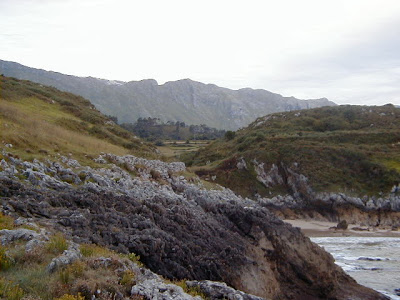
I took bread and wine back to my lair. The peasant farmer is a voyeur. He eats young female flesh with his eyes. I hope he confesses this in the Church he serves. He has favourite pitches amongst the rocks to feast from.
A fishing boat steams out, black smoke in its wake. I saw one come in today with four crew and five thin boxes of fish. Surely that was not a viable catch? If they got paid 50 pesetas for every gawper they could carry on. Local colour.
I have found a strange Spanish programme about los Beatles. It is decorating my camp so well I have to sit it out.
LA FEVE to SANTANDER
A brass band set up outside the station as day2 of the fiesta started. There were explosions of firecracker so loud that they echoed on the Picos lowering behind the town. My sleeping-bag wasn’t waterproof. This became uncomfortably apparent when a steady rain soaked through to my body.
Back on the Beanbag. Steaming out of Santander. Looking back at the hills and forest and townscape and quarried hills and smoke-plume, I realise I know a lot more about another human system than I did 10days ago.
There is scope for a grand tour of this planet. Call it a study in damage.
The Urb, Non-Urb thread is real. It is an international currency.
The two peasants whose domain I invaded, and the Llanes poet showed me that.
I like this ferry. I suppose we would have to row or heave up sails to get 5star arrival status. This is nearer to the wet&real part of the planet than easyjet or motorways. A strange gawkiness about the British that I admire: we are so discordant; perhaps the finest un-arrivers on the planet. We don’t know ourselves. We make do with or invent a working relationship with ourselves. Match & Mend.
Hang onto Habits. Improvise.
TWITCHERAMA
There is a forward viewpoint bedecked with optic whalewatchers. They scan the horizon. Someone sights a fin.
Scopes swivel, everyone focuses in. They run off with tripods to port & starboard to pursue their prey. There are 22 species of ceta that occupy the Bay of Biscay. They saw a Sperm earlier. Their blood is up. Ahab is in all of us.
The first thing an ecologist has to do is to study the local human fauna. They probably made the best, damaged the most and will control the result of his intervention.
PAST BREST
I pity French staff who serve the English their breakfasts; we have our own particular habits that we maintain religiously to help survive the start of the day. There was particular concern about fried eggs being placed on pieces of toast. Then the girl at the till had to assess all the eccentric combinations that we had made.
Back towards the sober coast of Britain. There is a grey mood in the air. The return to the unresolved complexities of working life and the credit card reckoning.
Referral to the wristwatch is denying NOW in real space; replacing the threads we have severed with shared human time as a poor substitute.

ENGLAND.
This Green Unpeasant Land. Farmers forgot a lot over 50years of MAFF. After Spain, the simple Scale of our mechanised monocultures is breathtaking. It is a lot to ask them now to dig up their grandfathers.
The Aber train/The runaway train/The only one I go on/that feels like it/Wants to get home
WHY do we come home ? and dive down burrows. leave that shining light behind and dive down into old habits and procedures and arguments and our side of the bed.
Travel is a class A drug. Like most of the others, withdrawal is painful...

Plymouth is drizzling with a fine summer sweat of anticipation that makes the ferry decks squeak with trainers. We perch like pigeons gazing south. Family man and family woman and their wriggling cherubs.

The deck starts to vibrate with volcanic engines and the ship vents a siren blast. Plymouth starts to shift askew.
We wander from deck to deck. Marauding rats. The instincts of familihood have mutated; gone rampant as a flag under which the worst of our selfishness can be expressed. I sit down opposite an old Indian lady in a white embroidered dress. She has bottled water and her shoes on the carpet by her feet. The marauding families scurry by.
The wake of this ferry is enormous, frothing the sea into a peppermint sorbet.

Kids fiddle hoping, with mobile-phones like a fading hot-line to god.
There is a classic female form that is pear-shaped. It is best not served with a custard of bad posture and diet. It certainly doesn’t suit men.
I would like to think that I am going home. I am fed up with this fat cuckoo culture. It is a neurotic mess.
They regard the absence of other ships to look at and a lumpy sea as some failure in the entertainment system. It must have been strange 200years ago when a sail on the horizon could be friend or foe. Aggressor or victim. Now we slap happy over the world’s sea in disregard.
There’s something to be said for smokers. Tobacco smoke was a wonderful incense. The underlying scent of humanity en-masse is slightly rotten. The overlay of perfumes and discinfectants that we use to disguise the smell of our excretions is nauseating.
Bring back the nosegay! Our own stink is acceptable. My emergency nosegay is to pull my teeshirt up over my face, should I be suddenly assailed by a turmoiling toilet or assault by drains.
It was a politeness to light up a cigarette in public if you farted.
An aromatic wristband, with a personally reassuring smell would be just as appropriate to a world of supposedly clean humanbeings as it was in times of more obvious nasal outrage.
19knots feels like riding a snail’s back across Planet Sea. Our wake curdles to the horizon. Around us the occasional white-horse crests in appreciation as this gargantuan sea-dod slithers past.

What is this boredom-thing? >the sullen un-engaged attention of the embroid blast&blather humanbeing.
Strange countryside. From the train. Instead of buddleia, festoons of pampasgrass, the ubiquitious bramble & bryony, some marestails.
Spanish are Stylish. They have a proud swing to their walk that is gracious or cruel. The English slab around like rubber ducks, even without their enormous backpacks & bedrolls.
The noses! Did those noble beaks come before, or because of their Pride?
It’s Too Hot. A lot of midday work seems to involve standing in the appropriate garb waiting for it to cool down.
Same industrial sprawl as UK. Pine & some eucalyptus plantations. The houses have pantiles and low-pitch (30degrees) but big overhang. Recognise elder, but not a multi-leaf sorbus tree. It’s hard to tell the colour of distant hillside forests through smoked glass of the train.
TORES PAPEL.> big beat-up green railtrucks with eucalyptus logs sticking out of them. – Pulp?
The pine forests look as single-age/clearfell as ours. A lof of new plantations are Uke. An ash! God-bless fraxinousE. Bracken,fennel,yarrow. A lot of this is railside which has its own discipline. More and more like Wales though.

It’s mad. Everyone smokes but the train is non-fumar. They get up individually to stand furtively by the door. One got words from the inspector just now. He nubbed it out and went sheepishly back to his seat.
Above that we climb. The Spanish mid-west. Grain and sunflowers. Mexico. The towns are a spaghetti-western film-set on Salisbury Plain. Clustered around Mother-ship churches. Miles of it.
One small step for a Spaniard. One giant leap for john spikes. The only interesting plants are railside thistles.
LEON.
They like life. They have no hunger to help the ignorant foreigner share their pleasures. The things they enjoy are sensual, so the young are not disadvantaged, as happens in N.Europe. the young inherit the culture readily. They smoke too many cigarettes though.
I reach starvation point before I ventured to order from a menu. The result promises to be a meal richer than my hunger, going by the starter.

They revere Babies and Dogs. Not plain old mongrels, but pedigree. Not your basic baby, but a little lord, lauded in splendid procession in his super-buggy.
The Old are still in some good-time domain. Shaded benches on plazas allow them to watch the world and play gallant. When they share a table with the young, they still steal the show. Here, there wasn’t the bullying beast of the anglo-saxon Nuclear Family. Couples were a dynamic tryst.
For good or bad.
The cathedral early. A guy was playing single sustained ascending notes on the organ on command from the tuner.
The glass was fantastic. The grotto icons lavish and absurd. God’s house needs a change of furniture.
The pilgrims were there, marked for the main by their canes. Café solo and fresh orange juice.
Leonists are proud to cruel. Cool to rude. A chip on the collective shoulder. The men are the worst. Disthroned Royalty.
WEST TO SANTIAGO.
Spain has a lot of industrial wasteland. Cement-works, quarrying, coal-waste, slate-waste.
Land squandered.
Pines galore in Galicia. A broader needle one to the west. Poplars in the bottomlands. Some Ukes like in the North. Firebreaks cut up to the summits like zips. A lot of local fire-damage.
SANTIAGO
The tortoise-race of backpackers to get to their guidebook hostels. Back in the international circuit of tourism. It helps at feeding time. A menu in English and a waiter who speaks 4 languages.
Shamed by a GrouchoMarx Ingles at near table, who sported a boater, and thought that the key to ethnicity was to eat finger-licking horrible and to be rude to the waiter. A performance clinched with a fat cigar. I avoid words. I have apologised to the waiter. My reward is a very good wine.
Was then invited to join a hen-party on another table. No-one spoke any Ingles. 2 were from the South and had done the 9 day pilgrimage, the other 3 were local friends. The waiter translated.
I thought my bill was hefty. I had paid for their food as well! Ignorant gallantry.
The market is on. Piled with the strangest fruit. A peasant economy overlooked by policia and tourists.
The bus station. Our bus is late, and what was a style-show of competing coach liveries is an almost empty bunker.
Santiago was Bones-R-Us. 1000year old Disney. Get a Stick & Walk the Trail and get a Shell-sticker. Phoney-as-hell. A Catholic theme-park. I fear for the young French girls who sang in sandals, the group of mountainbike pilgrims bunching for a photo in the square.
I head for the coast.
CAMARINAS
This is where I came in.
Monk’s Cave was where I first sat and waited for the world to happen. 30years on and still waiting.
These rocks are a grizzled red, painted by gulls and samphire in the fissures. I have a camera and a radio and carton of wine. Monk’s Cave was more Spartan.
Sitting on rocks with an incoming sea and a dying day. The shore for sure. Wrack to pick. Tides and Storms to talk. Loneliness to share.

Two ice-white fishing-boats come into view, streaming gulls like a bridal train. The one with most aerial bridesmaids steams ahead, while the other lingers at the mouth of the bay.
At night the lights and movements of large and little boats as they fish.
All that wood.
They don’t use it in their buildings. In the main part these are concrete-frame with hollow block infill. This means you often see a houseframe plus roof (concrete to be dressed with pantiles) left for ages before the next stage. The main wood-use seems to be for shuttering all that concrete, and eventually in details like turned balustrades etc. they have got plastic-window fever. It is even used for their large overhanging bay-windows.
Buses. The Spanish are just as confused, but to cool to show it, and too relieved when they board an appropriate bus to vent their trauma or moan that it is late.
Travel Early. A lot of bus&train activity is before 9am and if you miss that one isn’t until 3or4, so you end up at your destination hot and tired and all the pensions are complet.
There is a peasant farm&forest&fishing holding on the west coast that gets 5stars for bio-diversity, sustainability, all the eco-jargon you can blather.

>maize and pine and weird flat-topped brassicas and uke and crustacea and potatoes and fodder; though no evident animal enclosures.
I must find out the cash pyramid of the timber economy here. Big uke goes for pulp. UK timber has an industrial mean of 8foot, both for pulp and construction. Spanish mean looks shorter. Not short enough to manhandle, but too short to allow vertical headroom in structure. There are a lot of small timber mills who stack short sawn baulks out to dry and season.. there is a definite difference of landscape between what looks like the equivalent of the UK Forestry Commission land and peasant land. COTO PRIVADO DE CAZA.

What a day. Trying to get into a bit of someones’ backyard, which is a wild place to you, has similarities to a pilgrimage.
The best eco-systems are still in the hands of, or co-existent with peasants. Walking past them working they looked at me with incomprehension at best, at worst as a threat.
Spanish dogs bark as loud as ours.
You can’t just wander off the road into some unknown.
They live there. They are working the earth. In little parcels. Someone has sneaked a line of pumpkins onto the road-verge behind a fine wall of maize.
They know you are there. And can’t understand why.
CEDEIRA. The north coast.
My spirit sank as the bus got into Cedeira. It’s a squeaky clean resort in a cultivated valley. The slopes are plantation forests.
I trekked out. Again a test for the pilgrim. A pedestrian walking out of camp. I walk. I got looked at. I was hot and tired and uncertain where wilderness was. The houses were proud.. the wayside was full of old friends – wild carrot, marjoram, mint. Then there were the uke forests; well-worked but oppressive. A long valley. My map was inadequate. I turned up in weariness through some new pine plantations to find my destination.

A howling south-east wind. A hollow on the edge of a tumbling cliff-face, under some stunted pines .A savage shore.
Slept. Walked on to San Andreas, a strange peasant church, where the villagers were setting up gimcrack stalls against the wind.

Civilization starts to pile down the road in coach-loads. A lift to Camarinos and a midday beer. Away from that awful wind.
Hitchhiking must have no Spanish word. Their pride and scorn have a field-day in refusing to stop to give a lift. Endless swathes of Uke dress every hillside, with a line of windmills along the summit. No wilderness apparent here.
So I’ve relented, got a bus to a fishing village, O Banquiero and booked a cell in a Pension for 2nights. God-knows what I will do all day. Look at the harbour.
We have ceased to recognise Space as a sacred Part of the Earth. Places emanate Space
which has a flavour and viscosity that is particular. A local air.
The remnant of this knowledge is seen in that old currency of shrines, places of power, extremities. These were only approached appropriately by walking through true space to them, through the ordeal of walking through earth-space.
We have cut this Space and our sense of it to ribbons with our effortless transports; so we never arrive. We take images of our non-arrival away, as totems. As if the currency of collected totems and the splendour of our transports recompense for the fact that we never arrived.
Urban structures and human spaces and our dependence upon them is a poor alternative home for the human spirit. The energy we plunder to construct these ant-heaps is an hysterical attempt to forget what we have lost. Our urban shrines are designed to cater for a large throughput of lost beings, not-arriving (shopping malls, stadiums, city centres). These new shrines generate wealth that encourages the building of bigger ant-heaps. Our splendid transports generate income that encourage cutting more space to ribbons. The materials we use to construct our alternative to space is cropped and quarried from the remnants of real space.
The essence of our civilization is a strategy of savage denial of our loss.
We mock the few humanbeings left living in true space by mimicking aspects of their identity. Systems of conservation, organic foods etc.
I cannot see how we can reverse this ant-hill process. It would be foolish Pol-Pottery to imagine dragging our horde back into what is left of our original space. We are too committed to the pleasures of non-arrival. (lets go, lets go) . Real Space feels glutinous and oppressive to a race heady on the clear clean air of nowhere. Freedom is Movement. A peasant bent over a hoe is not what we really want to be again.
But let the air out of our tyres and the nature of space would change instantaneously. The alternative is to run around like bitten fleas until we exhaust our Host.
A small beach of silver sand, with a quarter of a mile of dune etc. I saw one token clump of sea-holly, but loads more beside. A small light violet flower, marjoram, a dwarf tufted grass etc.
There was a fine litter of broken shells and debris to pick over. The beach is a publically acceptable place of wildness to linger on. It’s good to stop. To kick white sprays of sand. To write with shells and whittle at a piece of driftwood.
The beach is space without the heady oppression of eden. Perfect for non-arrivers.
At least uke drop a leaf-litter. You can say that for them. But in all else, they are like moulting sticks dressed up in widow’s weeds. Enough is enough.
The Spaniards are expert trainers. They master their dogs and horses and children. Their mark is made. There are signs of the pudding-male here too. Men are losing it. The Spanish men don’t feel dressed without a shirt on. Undress on the street is not even considered. Even their teeshirts usually have a collar.
My father was a mechanical engineer. Big brother is an organic chemist. My son will be a microbiologist. I perch precariously on an obscure ledge on the cliff-face of knowledge.
OVIEDO. Is where I am spending money. I bought a pipe, at last, and a good teeshirt.
The Asturians have style. Their graphic sense is superb. There are chic shops with good things from allover. I want to know more about their ceramics- as this is the perfect plastic art for combining graphic and form.
I like this place.
The forests and valleys were not all uke.ok, or el paradiso like in northern Galicia. There was chestnut and hazel and pines and willow. I could live here, with Oviedo as my local city.
I go out to eat and drink. We are in an enclosed square under square white umbrellas, on wooden chairs for once. The flamboyant pouring of sideria from a great height wets the square. I avoid that palaver by ordering red wine, TIERRA ASTUR. Good stuff.
I have left a trail of belongings across Spain. Firstly a phrase-book and a floppy hat that I wouldn’t have worn anyway as it would have been the final flag of a grunge Englishman. Then a pair of half-dry socks & a teeshirt, that I had naively draped across my pack. Left in the streets of Leon. Then there was a day of disaster. I left the rocks of Camarinas early, to catch the bus north, then ran back for my wash-bag. I couldn’t find it. In the square I got hassled by the town-drunk for tobacco. I must have dropped my pipe in the road as I boarded the bus.
“I left my pipe in Camarinas”. I then found that one of my two pairs of trousers was so glued with oil from the beach that they were finished. The final loss was my sunglasses, left as I had perched to drink from a spout on the trek out of Cedeira.
A week of that kind of loss, and I would have disappeared.
I broke the Oviedo pipe by sitting on it halfanhour before the train left. Miraculous quest for supaglue.
OVIEDO. It’s not just the streets are clean.(they seem to spend most of the early hours power-cleaning them) They are expert at attractive and comfortable paving; puckered marble, grooved tiles etc. I would gladly have gone barefoot except that would have marked me out further as an eccentric foreigner. A lot of money and style is invested by the Spanish in their footware.
To the West, a refreshing dominance of hardwoods. Alder along their stagnant rivers. Hazel, Sweet Chestnut, Ash, Maple, Oak, plus planted Poplars. The high ridges spike with remnant Pine. Orchards (cider) Maize, a few fine cattle. Heading on La FEVE for Llanes.
Sitting amongst sea lavender and samphire on a limestone outcrop at Llanes. I want to cry in some weird self-pity because it is all so fucking amazing.
The Spanish urbs are stuck round the corner strutting their stuff. They have stylised themselves into their own national version of loneliness. The men are like emasculated bulls. The women are immaculate bitches, well-dressed to kill.
Again I had to go through the war-zones: town>pension,hostal etc COMPLET>campite zone>abandoned holdings. I started scratching a flat piece under a rock for myself about four.pm Not ideal. No breeze and too many possible wanderers. A man paced the beach below. He knew I was there. He walked up a path in a way that told me he belonged there. I reassembled my pack and followed him. I asked permission. I am now sleeping on his land, a fine ledge under a couple of gorse-bushes. The gulls gossip around me. Wilderness pitch Three.

I took bread and wine back to my lair. The peasant farmer is a voyeur. He eats young female flesh with his eyes. I hope he confesses this in the Church he serves. He has favourite pitches amongst the rocks to feast from.
A fishing boat steams out, black smoke in its wake. I saw one come in today with four crew and five thin boxes of fish. Surely that was not a viable catch? If they got paid 50 pesetas for every gawper they could carry on. Local colour.
I have found a strange Spanish programme about los Beatles. It is decorating my camp so well I have to sit it out.
LA FEVE to SANTANDER
A brass band set up outside the station as day2 of the fiesta started. There were explosions of firecracker so loud that they echoed on the Picos lowering behind the town. My sleeping-bag wasn’t waterproof. This became uncomfortably apparent when a steady rain soaked through to my body.
Back on the Beanbag. Steaming out of Santander. Looking back at the hills and forest and townscape and quarried hills and smoke-plume, I realise I know a lot more about another human system than I did 10days ago.
There is scope for a grand tour of this planet. Call it a study in damage.
The Urb, Non-Urb thread is real. It is an international currency.
The two peasants whose domain I invaded, and the Llanes poet showed me that.
I like this ferry. I suppose we would have to row or heave up sails to get 5star arrival status. This is nearer to the wet&real part of the planet than easyjet or motorways. A strange gawkiness about the British that I admire: we are so discordant; perhaps the finest un-arrivers on the planet. We don’t know ourselves. We make do with or invent a working relationship with ourselves. Match & Mend.
Hang onto Habits. Improvise.
TWITCHERAMA
There is a forward viewpoint bedecked with optic whalewatchers. They scan the horizon. Someone sights a fin.
Scopes swivel, everyone focuses in. They run off with tripods to port & starboard to pursue their prey. There are 22 species of ceta that occupy the Bay of Biscay. They saw a Sperm earlier. Their blood is up. Ahab is in all of us.
The first thing an ecologist has to do is to study the local human fauna. They probably made the best, damaged the most and will control the result of his intervention.
PAST BREST
I pity French staff who serve the English their breakfasts; we have our own particular habits that we maintain religiously to help survive the start of the day. There was particular concern about fried eggs being placed on pieces of toast. Then the girl at the till had to assess all the eccentric combinations that we had made.
Back towards the sober coast of Britain. There is a grey mood in the air. The return to the unresolved complexities of working life and the credit card reckoning.
Referral to the wristwatch is denying NOW in real space; replacing the threads we have severed with shared human time as a poor substitute.

ENGLAND.
This Green Unpeasant Land. Farmers forgot a lot over 50years of MAFF. After Spain, the simple Scale of our mechanised monocultures is breathtaking. It is a lot to ask them now to dig up their grandfathers.
The Aber train/The runaway train/The only one I go on/that feels like it/Wants to get home
WHY do we come home ? and dive down burrows. leave that shining light behind and dive down into old habits and procedures and arguments and our side of the bed.
Travel is a class A drug. Like most of the others, withdrawal is painful...
Friday, 11 January 2008
4> Trees and All That. part two
I have been gazing at an aerial photo of the valley I live in now.
In 1946 it looks a denuded wasteland, holding less than half the trees now growing here.
Woods that I had taken for granted as dripping West Wales rain-forest are only sixty years old. There is not a shred of bush or stump in view. You can trace where the ribs of rock ridges show through, as if the earth was starved after five years of total war. Like an over-worked horse.
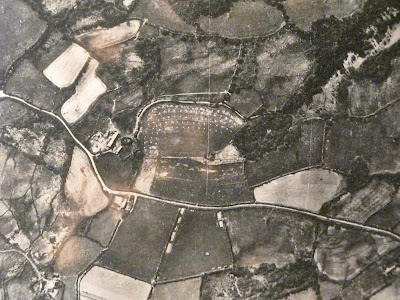
Bald bites of clearfell glare bright inside what woods remain. Fields long since sunk into marginal grazing are pockmarked with regular heaps of lime or slag ready for spreading.
The enormity of how different it is hasn’t sunk in. I need to gaze at it for hours.
We have built an idyll of an earlier landscape expressing peasants' intimate care, when perhaps it was as scavenged and bare as third-world peasant landscapes are today.
What it does here though is explain how happily people embraced the large-scale Forestry Commission coniferous plantings after the war as welcome totems of new growth in such a scarred and hard-faced landscape.
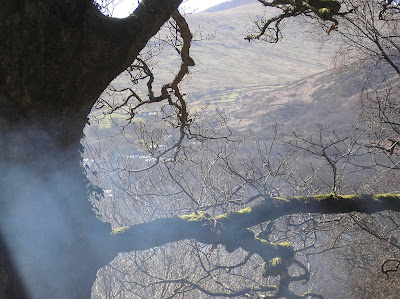
After I had picked my way through those young moorland Sitka plantations for a day’s moss, I could call on the district forester, Glyn Jones, who knew his patch pretty well, so we could share information.
He lent me a boot-full of forestry in-house periodicals. They start by extolling the vigour and excitedly charting likely yields of the various conifer species being planted.
Leafing on ten years, articles on how to combat different mites and rusts and squirrel attacks dominate.
Another ten years and the absence of any realistic price has dawned, along with discussions on ‘re-spacing’ to counter ‘wind-throw’, and how to avoid the attack of spruce-bark beetles.
It was bleak reading.
Having been re-elected on a landslide, Margaret Thatcher was just starting to ‘rationalise’ the Forestry Commission, by making them sell their less profitable holdings. They had dragged their heels during her first term of office, so she was out for blood.
I suspect that they were still deluding themselves, or wearing the invisibility coat of pride, in not admitting that none of the forests they managed were, or were ever likely to be, profitable in current Monetary terms. (When that creed’s logic was eventually extended to embrace the Whole Earth's economy of carbon credits and sinks, the case changed, but too late for the FC estate. )
They idiotically decided to sell of their more diverse, older woods, keeping the sitka monocrop moorland forests: that needed no more subtle management than a mad monkey or a timely box of matches could have given.
That was when I became a woodland owner rather than just a nomadic watcher of events. It was the start of a time when I seemed to know less each day.
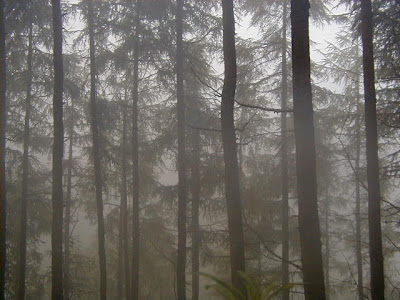
Twenty years on and we all I hope know more of that less. There is a lot to unlearn.
People tell me that the Forestry Commission has changed, but I suspect its underlying default of proactive regulation to maximise tree growth remains.
There is a kind of deft, cursory care that the natural world seems to love and respond to. These ‘little disturbances of man’ can trigger response in quiescent ecosystems.
I remember hearing of an elaborate scheme to raise water-levels on Borth Bog, the flower of which was a long pool filling a rut left by a tracked digger.
This was a lesson of 'chance, occurrence overwhelming prescriptive control. Heart over Head.
In 1946 it looks a denuded wasteland, holding less than half the trees now growing here.
Woods that I had taken for granted as dripping West Wales rain-forest are only sixty years old. There is not a shred of bush or stump in view. You can trace where the ribs of rock ridges show through, as if the earth was starved after five years of total war. Like an over-worked horse.
Bald bites of clearfell glare bright inside what woods remain. Fields long since sunk into marginal grazing are pockmarked with regular heaps of lime or slag ready for spreading.
The enormity of how different it is hasn’t sunk in. I need to gaze at it for hours.
We have built an idyll of an earlier landscape expressing peasants' intimate care, when perhaps it was as scavenged and bare as third-world peasant landscapes are today.
What it does here though is explain how happily people embraced the large-scale Forestry Commission coniferous plantings after the war as welcome totems of new growth in such a scarred and hard-faced landscape.
After I had picked my way through those young moorland Sitka plantations for a day’s moss, I could call on the district forester, Glyn Jones, who knew his patch pretty well, so we could share information.
He lent me a boot-full of forestry in-house periodicals. They start by extolling the vigour and excitedly charting likely yields of the various conifer species being planted.
Leafing on ten years, articles on how to combat different mites and rusts and squirrel attacks dominate.
Another ten years and the absence of any realistic price has dawned, along with discussions on ‘re-spacing’ to counter ‘wind-throw’, and how to avoid the attack of spruce-bark beetles.
It was bleak reading.
Having been re-elected on a landslide, Margaret Thatcher was just starting to ‘rationalise’ the Forestry Commission, by making them sell their less profitable holdings. They had dragged their heels during her first term of office, so she was out for blood.
I suspect that they were still deluding themselves, or wearing the invisibility coat of pride, in not admitting that none of the forests they managed were, or were ever likely to be, profitable in current Monetary terms. (When that creed’s logic was eventually extended to embrace the Whole Earth's economy of carbon credits and sinks, the case changed, but too late for the FC estate. )
They idiotically decided to sell of their more diverse, older woods, keeping the sitka monocrop moorland forests: that needed no more subtle management than a mad monkey or a timely box of matches could have given.
That was when I became a woodland owner rather than just a nomadic watcher of events. It was the start of a time when I seemed to know less each day.

Twenty years on and we all I hope know more of that less. There is a lot to unlearn.
People tell me that the Forestry Commission has changed, but I suspect its underlying default of proactive regulation to maximise tree growth remains.
There is a kind of deft, cursory care that the natural world seems to love and respond to. These ‘little disturbances of man’ can trigger response in quiescent ecosystems.
I remember hearing of an elaborate scheme to raise water-levels on Borth Bog, the flower of which was a long pool filling a rut left by a tracked digger.
This was a lesson of 'chance, occurrence overwhelming prescriptive control. Heart over Head.
Thursday, 10 January 2008
3>Trees and All That . part one
You don’t realise what you take for granted, your body of knowledge, until it is called upon or challenged. I have been wandering in the gloom of woods for enough years now to have long lost the trail of white stones that lead back to the trodden path, or the wish to do so.
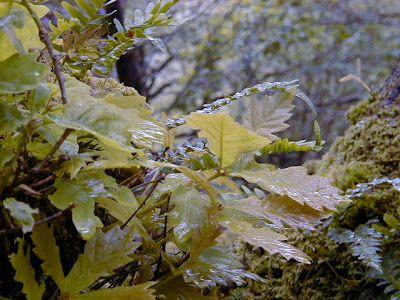
Most of our current mainstream mantras about trees and woodland have come to seem such emotionally-loaded and inaccurate bollocks, that it’s hard to find a shared clearing in which to start to describe things from my point of view.
Cutting down trees is wrong. So the story goes. They teach it in primary school. The woe and guilt for a lost Eden is cast upon the woodsman. We carry the blame for the sense of disociation felt by urban man. It is a motto as simple and shallow as ‘greedy farmers’.
The exercise of righteousness rather than the effort of understanding. We all do it.
I spent my childhood painfully negotiating ascent up garden trees that I only knew by species years later. A couple of birches were friendly. Two copper beeches were more of a challenge but were a whole dark, secret world inside. My brother had commandeered a huge sycamore for his fastness, but my giant was a many tiered elm, as intricate a climb as Jack’s beanstalk. We had built a platform on every possible level. Gazing from the top, I felt like Doctor Who, looking out over a gleaming, distant urban dreamscape, that was in fact Birmingham’s emergent Bull Ring. That tree fell spectacularly a few years after we had moved. The Bull Ring is being clawed down now too.
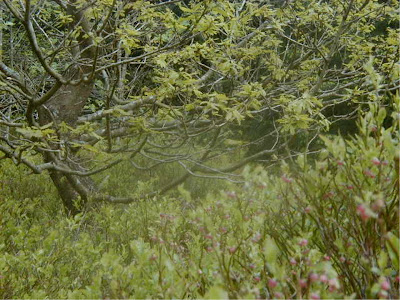
Apart from these early friends, trees were mainly just the bigger greenstuff that filled up the bits between buildings. The flat stuff was grass.
Having learnt a bit more since then, I try to remember that green is green to most, indistinguishable whether they are looking out over an intensive dairy sward or a long tended hay meadow.
I didn’t really take trees seriously until led there by the logic of my living.
I was after moss, which grows, as you know, between trees. Explanations are like branches, which can lead to thinner and thinner twigs, so let’s just accept that moss was a mission that led me down many a dark bank and into places long untrod.
This was in the Era of the Great Smother.
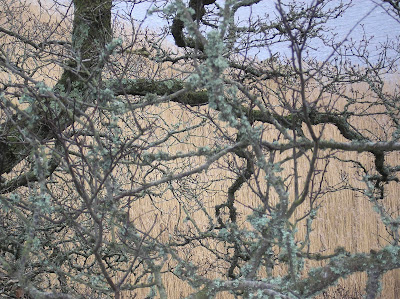
The Forestry Commission had eagerly planted as many bits of moorland and woodland that had been ransacked for the War, as it could acquire, with plantations, mainly of coniferous trees, and mainly of Sitka Spruce, at regular three foot intervals. Millions of them.
Literally millions were planted between 1955 and 1965.
Literally millions.
The government were acting out resolutions made during years of siege by ‘U’boat. Governments it seems, have a tendency to act out all the things they feel they should have done before the last war, as if the next one will be a re-run.
Elsewhere, demobbed male zeal wore out a plough an hour planting groundnuts.
Africa perhaps heals more quickly. We still look out on the ragged outlines of conifers long past their fell-by dates, largely ignored by a Forestry Commission that has put more effort into virtual forest models and remodelling its public image.
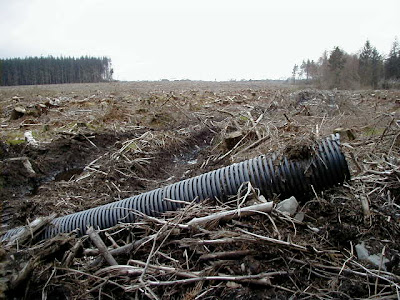
I ventured into forests that were still quietly swallowing peasant landscapes. There were Sitka dangling innocently over old lanes that led to moorland holdings. Bilberry and rowan still grew on field banks in the rides before the wall of Sitka blanketed them.
I saw these plantations grow, and then fall down from inside, trees leaning on each other, broken and creaking.
The Age of Harvesters arrived to swipe them off at the butt, leaving the stumps to be flipped into tangles by a lonely hymac, looking for new clay beneath the peat, for the contract planters to pick their way to, cramming a new generation of sitka clones into place.
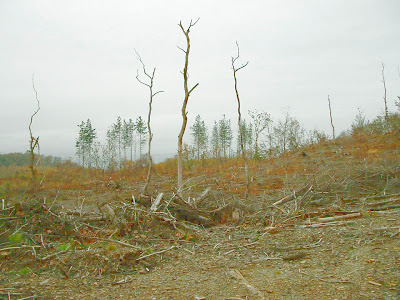
There were valley woodlands where some valiant ash regrowth was never beaten by planted Spruce and Larch, but most deciduous stools succumbed to the conifer shadow, and larger stems were ring-barked.
Western Hemlock will grow in semi-shade, so was favoured to ‘fatten up’ old woodlands. Unfortunately, it is vulnerable to stump-rot, which thrives in an ancient forest-floor. Nobody wanted the timber anyway, which was impossible to peel, prone to deep fissures, and wouldn’t even burn well.
It still occupies many woods, blocking the seedbed, and ready to seed itself if a chink in the canopy occurs. There were other disastrous exotics planted, but this is not the place to detail them.
This is not the dock of an ecological war-crimes trial.
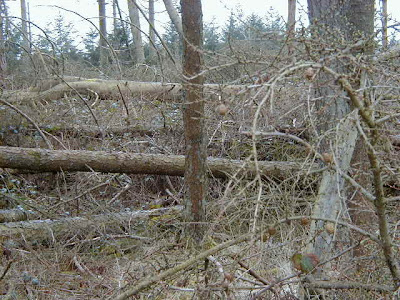

Most of our current mainstream mantras about trees and woodland have come to seem such emotionally-loaded and inaccurate bollocks, that it’s hard to find a shared clearing in which to start to describe things from my point of view.
Cutting down trees is wrong. So the story goes. They teach it in primary school. The woe and guilt for a lost Eden is cast upon the woodsman. We carry the blame for the sense of disociation felt by urban man. It is a motto as simple and shallow as ‘greedy farmers’.
The exercise of righteousness rather than the effort of understanding. We all do it.
I spent my childhood painfully negotiating ascent up garden trees that I only knew by species years later. A couple of birches were friendly. Two copper beeches were more of a challenge but were a whole dark, secret world inside. My brother had commandeered a huge sycamore for his fastness, but my giant was a many tiered elm, as intricate a climb as Jack’s beanstalk. We had built a platform on every possible level. Gazing from the top, I felt like Doctor Who, looking out over a gleaming, distant urban dreamscape, that was in fact Birmingham’s emergent Bull Ring. That tree fell spectacularly a few years after we had moved. The Bull Ring is being clawed down now too.

Apart from these early friends, trees were mainly just the bigger greenstuff that filled up the bits between buildings. The flat stuff was grass.
Having learnt a bit more since then, I try to remember that green is green to most, indistinguishable whether they are looking out over an intensive dairy sward or a long tended hay meadow.
I didn’t really take trees seriously until led there by the logic of my living.
I was after moss, which grows, as you know, between trees. Explanations are like branches, which can lead to thinner and thinner twigs, so let’s just accept that moss was a mission that led me down many a dark bank and into places long untrod.
This was in the Era of the Great Smother.
The Forestry Commission had eagerly planted as many bits of moorland and woodland that had been ransacked for the War, as it could acquire, with plantations, mainly of coniferous trees, and mainly of Sitka Spruce, at regular three foot intervals. Millions of them.
Literally millions were planted between 1955 and 1965.
Literally millions.
The government were acting out resolutions made during years of siege by ‘U’boat. Governments it seems, have a tendency to act out all the things they feel they should have done before the last war, as if the next one will be a re-run.
Elsewhere, demobbed male zeal wore out a plough an hour planting groundnuts.
Africa perhaps heals more quickly. We still look out on the ragged outlines of conifers long past their fell-by dates, largely ignored by a Forestry Commission that has put more effort into virtual forest models and remodelling its public image.

I ventured into forests that were still quietly swallowing peasant landscapes. There were Sitka dangling innocently over old lanes that led to moorland holdings. Bilberry and rowan still grew on field banks in the rides before the wall of Sitka blanketed them.
I saw these plantations grow, and then fall down from inside, trees leaning on each other, broken and creaking.
The Age of Harvesters arrived to swipe them off at the butt, leaving the stumps to be flipped into tangles by a lonely hymac, looking for new clay beneath the peat, for the contract planters to pick their way to, cramming a new generation of sitka clones into place.

There were valley woodlands where some valiant ash regrowth was never beaten by planted Spruce and Larch, but most deciduous stools succumbed to the conifer shadow, and larger stems were ring-barked.
Western Hemlock will grow in semi-shade, so was favoured to ‘fatten up’ old woodlands. Unfortunately, it is vulnerable to stump-rot, which thrives in an ancient forest-floor. Nobody wanted the timber anyway, which was impossible to peel, prone to deep fissures, and wouldn’t even burn well.
It still occupies many woods, blocking the seedbed, and ready to seed itself if a chink in the canopy occurs. There were other disastrous exotics planted, but this is not the place to detail them.
This is not the dock of an ecological war-crimes trial.

Subscribe to:
Comments (Atom)